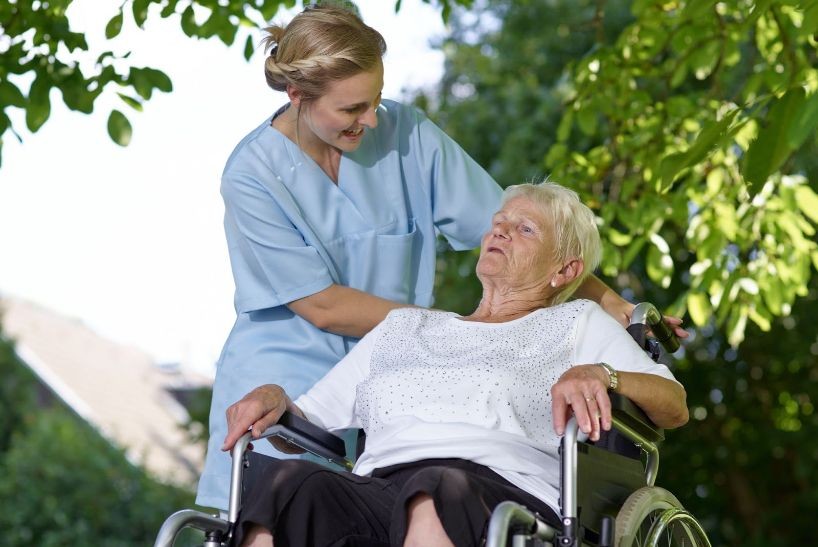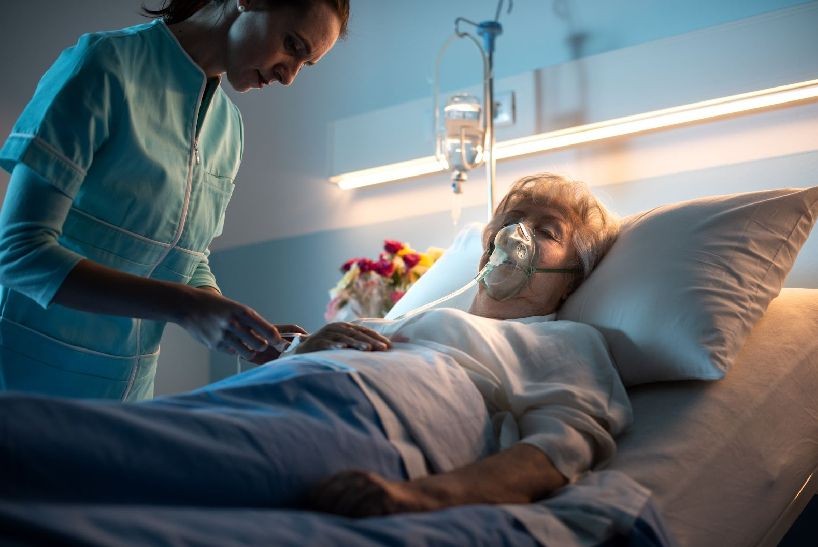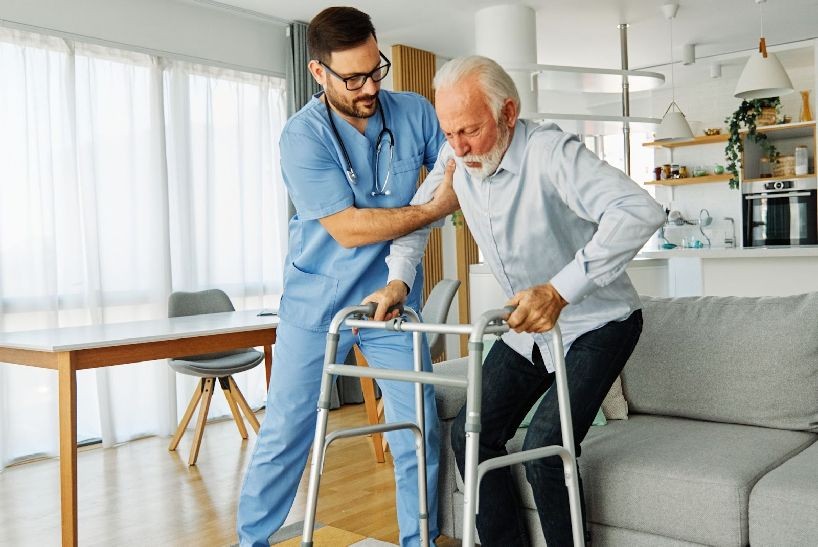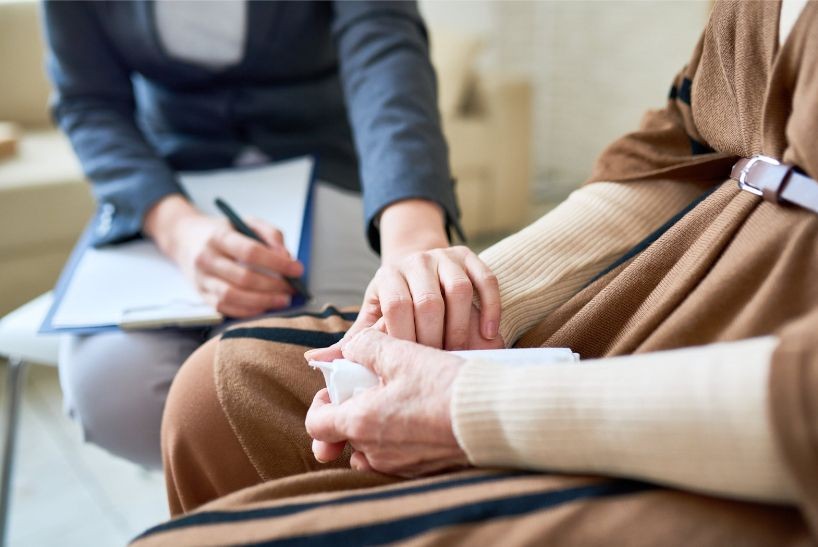Home Treatment: HospitalAtHome
Specialist topics
Home Treatment: HospitalAtHome
The hospital landscape in Switzerland is on the verge of change. According to forecasts, the number of hospitals will continue to decrease over the next few years. Clients will be sent home earlier and receive help there via digital and information technology. The HospitalAtHome trend can be observed internationally.

What does HospitalAtHome mean?
Clients with various illnesses usually have to be treated as inpatients in a hospital. In these cases, the HospitalAtHome treatment concept enables them to receive therapy within their own four walls. Clients benefit from various advantages, including
- better adaptation of the therapy to the normal circumstances at home
- Familiar surroundings for an increased sense of well-being
- a stronger feeling of being responsible for their own health and recovery process
How important is it for clients to take responsibility for themselves?
Studies show that clients with chronic illnesses experience a more positive outcome when they actively participate in therapy. Thanks to new technologies for monitoring and therapy application, illnesses can be controlled more by the patients themselves. This also gives chronically ill and elderly people the opportunity to stay in their familiar environment for longer.
In future, health self-management should also include prevention. With the help of internet-based services, healthy people can monitor their condition on a regular basis. This is possible thanks to appropriate devices and monitoring technologies, which are to be further improved in the coming decades.
Why is home care becoming more and more important?

The Swiss population is getting older and older. This is a sign of excellent living conditions and ever-improving medical care options. However, at a certain point, the healthcare system faces a major challenge.
As the population ages, the number of people with chronic illnesses also increases. This results in an increased need for medical care, but this is offset by a shortage of specialists. In order to meet this need, however, home care is becoming increasingly important.
What impact does HospitalAtHome have on the healthcare sector?

Due to the increasing age of the population and their demands on medical care, the healthcare system is facing a challenge. The burden is increasing and with it the pressure to use financial resources as efficiently as possible. HospitalAtHome can help to solve these problems, as it relieves the burden on hospitals. Thanks to the stay-at-home concept, hospitals have more capacity to deal with acute emergencies.
This treatment concept can also save money, as demonstrated by the large hospital group Brigham Health in the USA. Doctors and nurses visit clients twice a day and carry out the necessary tests and examinations.
They use a wireless sensor to monitor vital signs and can be reached at any time via video chat. Brigham shows that the cost of treatment at home is only around half that of an inpatient stay.
The lower costs are mainly due to the lower personnel costs. Although medical staff are on call at all times, they are contacted much less frequently from home than in hospital. This gives doctors more time for other clients.
How does treatment via HospitalAtHome work?
If there is a medical emergency, clients first present themselves at the hospital. A comprehensive diagnosis is carried out there and an assessment is made of which treatments are necessary to ensure the best possible recovery. The doctors analyze whether these are also possible in the client's own four walls.
If the answer is yes, a meeting is held with them and their relatives. If everyone involved agrees, the next step is to plan and organize the HospitalAtHome. Depending on the concept that has been developed, care is provided several times a day. Of course, the doctors are always on hand in an emergency. If the patient's state of health deteriorates, they will be taken back to hospital.
Swiss examples of HospitalAtHome

Zollikerberg Hospital is one of the pioneers of HospitalAtHome in Switzerland. In line with the motto "outpatient before inpatient", clients will be able to receive treatment at home from late fall 2022.
This will be the case for illnesses such as pneumonia, COPD or heart failure. The prerequisite is that the client's home is no more than five kilometers away from the hospital. In addition, they must not live alone.
Nevertheless, the initial diagnosis is made in hospital. Acute medical treatment, on the other hand, then takes place at home. Doctors and nursing staff carry out rounds several times a day.
In addition, there is telemedical monitoring around the clock. For this purpose, a sticker is attached to the client's chest. Heart rate and respiratory rate are monitored and the data reaches the hospital in real time. If one of these values develops in a direction that could endanger health, an alarm is triggered immediately. Medical help is then dispatched immediately.
Measuring blood pressure and oxygen saturation as well as ultrasound examinations and ECGs are also possible at home thanks to mobile devices. These results are also forwarded to the hospital immediately. Of course, clients also have the option of contacting the doctors treating them around the clock.
HospitalAtHome at Zollikerberg Hospital is not about gradually abolishing inpatient stays. Rather, the aim is to promote the autonomy of clients. The feel-good factor, which is significantly enhanced by treatment in familiar surroundings, also plays a major role.
What challenges does HospitalAtHome pose?

Clients who have been waiting a long time for treatment during an emergency may feel uncomfortable. They often expect comprehensive care on site and may feel neglected if they are sent home.
Therefore, an intensive discussion is necessary in advance to clarify whether the clients really agree to this. Under no circumstances should the feeling of safety be neglected. If the client's state of health deteriorates or complications arise, they can of course return to hospital at any time.
It should be noted, however, that medical help does not arrive within seconds. It takes a few minutes for an ambulance to arrive, or even longer in some circumstances. It also takes time to get to the hospital. This time window must not have a critical impact on the health of the client. This must be taken into account before the HospitalAtHome concept is even considered.
The Swiss healthcare system in transition
HospitalAtHome has already established itself in countries such as the UK and the USA and the results of studies carried out there are very promising. This concept is slowly finding its way into Switzerland and could revolutionize the healthcare system.
We at OPAN® are also in favor of progressive thinking in medicine and care. Would you like to find out more about HospitalAtHome or are you thinking about using Spitex? Then please do not hesitate to contact us.
